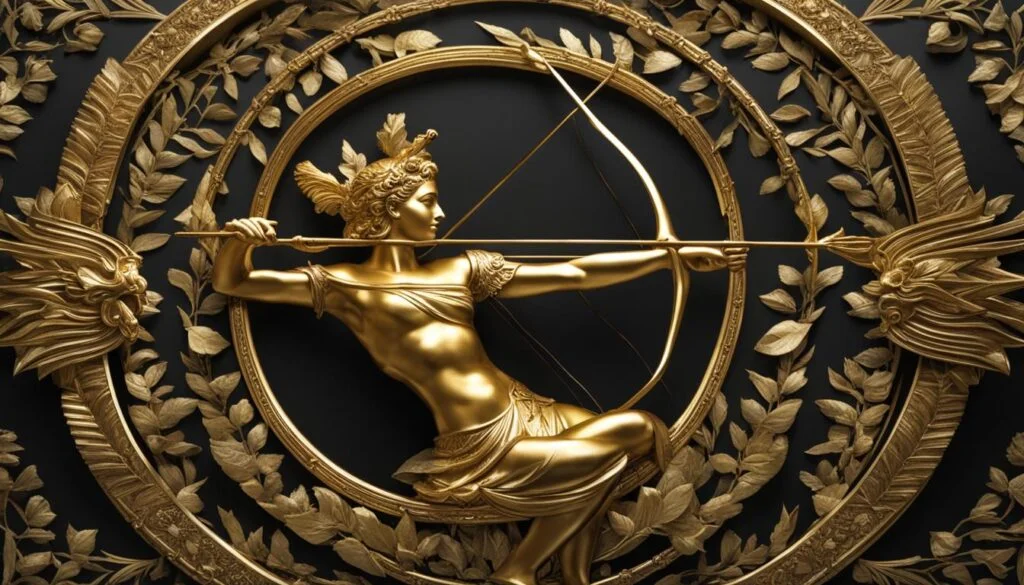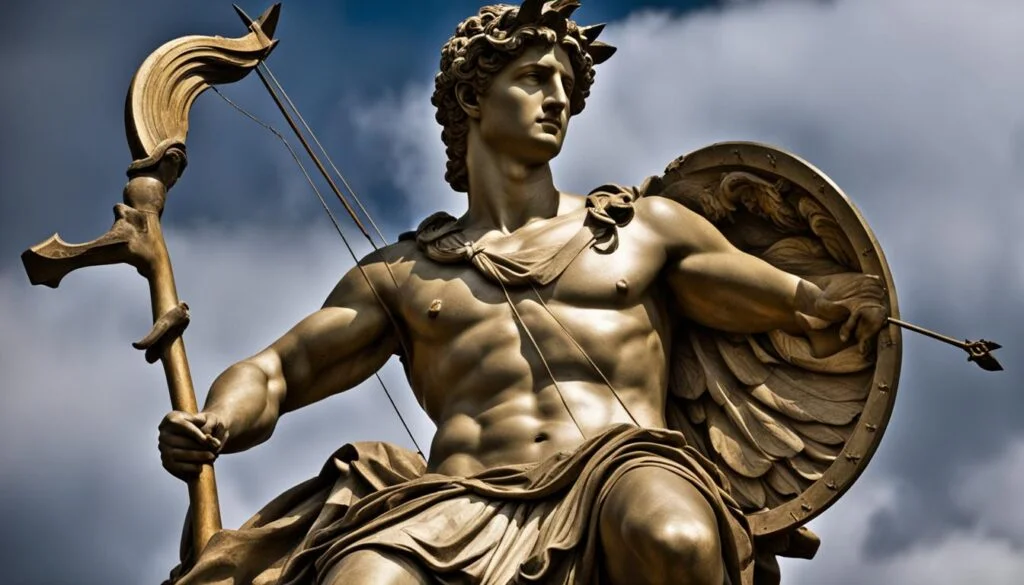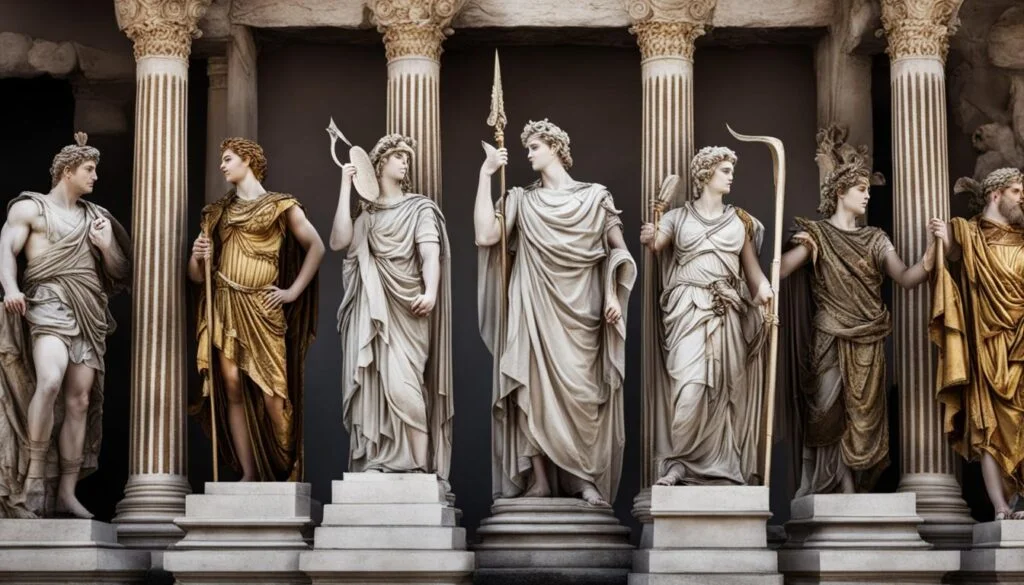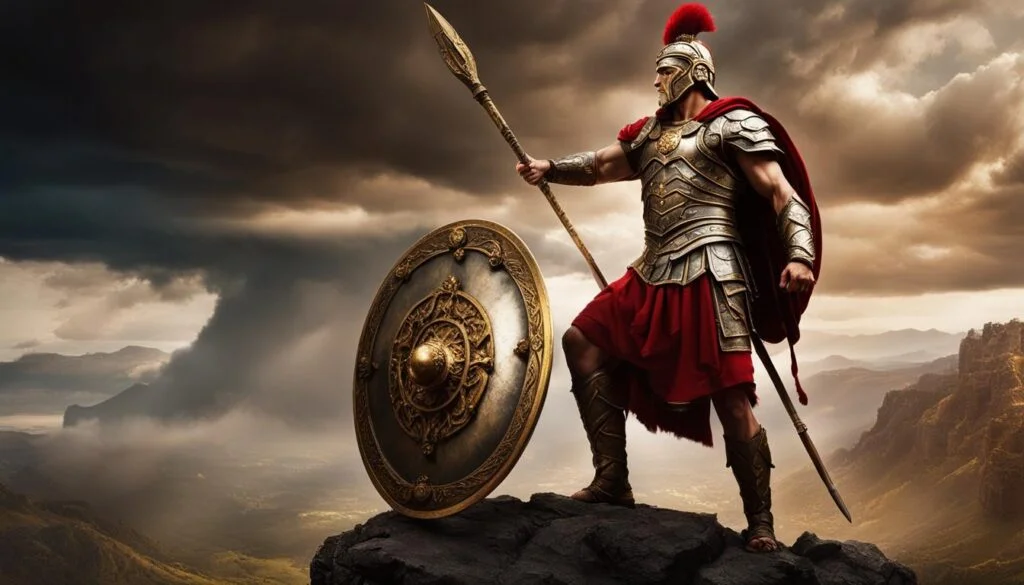Curious about the origins and role of Apollo in Roman mythology? Look no further!
In this article, we delve into the rich history and significance of this revered deity, shedding light on his fascinating attributes and contributions in the pantheon.
Key Takeaways
- Apollo is a prominent god in Roman mythology, revered for his diverse roles as the god of music, poetry, sun, healing, and prophecy.
- He is the son of Jupiter (Zeus) and Leto (Latona) and has a close relationship with his twin sister, Diana (Artemis).
- Apollo’s symbols include the sun, the lyre, the bow and arrow, the laurel wreath, and the tripod.
- He is frequently depicted in various forms of art and architecture, showcasing his importance in ancient Roman culture.
- Exploring Apollo’s role in Roman mythology provides insights into the vibrant and complex belief system of ancient Rome.
The Mythology of Apollo
Apollo, one of the ancient Roman gods in the vast pantheon, is a figure shrouded in captivating mythology.
This god of music, poetry, sun, healing, and prophecy boasts an array of tales and legends that highlight his diverse roles and associations.
Apollo’s mythology not only showcases his immense power but also offers insights into the complex belief system of ancient Rome.
Throughout the mythology of Apollo, he is depicted as a multifaceted deity with various attributes and responsibilities.
As the god of music, Apollo is often portrayed playing the lyre, a musical instrument associated with harmony and creativity.
In his role as the god of the sun, he radiates brilliance and light, symbolizing warmth, illumination, and the cycle of life.
Additionally, Apollo is revered as the god of healing, whose gentle touch can cure ailments and bring about renewal and well-being.
One of the most significant aspects of Apollo’s mythology is his association with prophecy.
Known as the god of prophecy, Apollo possesses the ability to see into the future and provide guidance to mortals.
His most famous oracle, the Oracle of Delphi, was sought by many for their inquiries and predictions.
Through this aspect of his mythology, Apollo represents wisdom, foresight, and the connection between the divine and mortal realms.
As we delve into the rich mythology surrounding Apollo, we discover the captivating stories and symbolism that contribute to his status as one of the revered figures in the Roman pantheon.
From his role as the god of music and healing to his association with the sun and prophecy, Apollo’s mythology provides a glimpse into the beliefs and values of ancient Roman society.
The Family and Relationships of Apollo
Apollo, the esteemed deity in Roman mythology, is not only known for his various domains but also for his intricate family connections within the Roman pantheon. Let’s delve into the family tree of this influential god and explore his significant relationships.
The Divine Parents: Jupiter and Leto
Apollo is the son of Jupiter, also known as Zeus in Greek mythology, and Leto, who is referred to as Latona in Roman mythology. Jupiter, the king of the gods, and Leto, a Titaness, bestowed upon Apollo his divine lineage and immense power.
The Twin Sister: Diana
One of the most fascinating relationships Apollo shares is with his twin sister, Diana, who is known as Artemis in Greek mythology. Diana is the goddess of the hunt, moon, and childbirth. The bond between Apollo and Diana is strong, and they often collaborate in various mythological tales and adventures.
The Extended Divine Family
Apollo’s divine family extends beyond his immediate relatives. He is part of the larger Roman pantheon, which includes other prominent gods and goddesses. His relatives include Jupiter, the father of all gods; Juno, the queen of the gods and Jupiter’s wife, also known as Hera in Greek mythology; and Venus, the goddess of love and beauty, known as Aphrodite in Greek mythology.
By exploring Apollo’s family connections, we gain a deeper understanding of the intricate relationships within the Roman pantheon and the divine dynamics that shape the world of mythology.
Symbols and Attributes of Apollo

Apollo, the revered god in Roman mythology, is associated with a myriad of symbols and attributes that reflect his diverse domains and roles within the ancient Roman pantheon. These symbols are significant representations of Apollo’s character, power, and influence. Let’s delve into some of the key symbols and attributes attributed to Apollo:
1. The Sun
One of Apollo’s most prominent symbols is the sun, representing his association with light and illumination. As the sun god, Apollo embodies the radiance and warmth that the sun brings to the world. Often depicted riding a golden chariot across the sky, Apollo’s connection with the sun signifies his role as a bringer of life and vitality.
2. The Lyre
The lyre, a musical instrument resembling a small harp, is another significant symbol of Apollo. As the god of music and poetry, Apollo is often portrayed playing the lyre to create harmonious melodies that soothe the souls of both gods and mortals alike. The lyre also represents Apollo’s creative and artistic nature.
3. The Bow and Arrow
Apollo is frequently depicted wielding a bow and arrow, symbolizing his association with archery and hunting. This attribute highlights his skill as a master archer and reinforces his role as a protector and defender.
4. The Laurel Wreath
The laurel wreath, made from the leaves of the bay laurel tree, is a symbol of victory and honor. Apollo is often depicted wearing a laurel wreath on his head, signifying his triumphs and achievements. The laurel wreath also represents Apollo’s association with divine inspiration and his role as a patron of poets and artists.
5. The Tripod
The tripod is a unique symbol associated with Apollo, representing his connection to prophecy and oracles. In ancient Greece and Rome, a tripod was a three-legged stand upon which an oracle would sit. Apollo is considered the god of prophecy, and the tripod serves as a visual representation of his role as the conduit between the mortal and divine realms.
These symbols and attributes provide us with a deeper understanding of the multifaceted nature of Apollo’s character and his significant role in the ancient Roman pantheon.
Apollo in Art and Architecture

Apollo’s influence in ancient Roman culture goes beyond mythology and extends into the realm of art and architecture. Throughout history, he has been depicted in various artistic forms, including statues, reliefs, frescoes, and mosaics. These artistic representations not only showcase Apollo’s importance in Roman society but also provide insights into the beliefs and values of the time.
One of the most prevalent artistic depictions of Apollo is in sculptural form. Statues of Apollo can be found in temples and public spaces, capturing his divine and majestic presence. These statues often portray him with his iconic attributes, such as the lyre, representing his role as the god of music, and the laurel wreath, symbolizing victory and poetic inspiration.
Another prominent representation of Apollo can be seen in architectural structures dedicated to him. Temples dedicated to Apollo were built throughout ancient Rome, serving as places of worship and reverence. These temples were designed with architectural grandeur, reflecting the divine status of the god they were built to honor.
Apollo in Roman Mosaics
Apollo’s image can also be found in Roman mosaics, which were intricate designs made using small pieces of colored glass or stone embedded in mortar. These mosaics adorned the floors and walls of villas, public buildings, and even tombs. Apollo was often depicted in these mosaics engaged in various activities, such as playing the lyre or driving his golden chariot across the sky.
- Alt attribute: Apollo symbols
The artistry and craftsmanship behind these mosaics showcased the skill and creativity of ancient Roman artisans. They served not only as decorative elements but also as a means to honor and pay tribute to the gods, including Apollo, within the Roman pantheon.
Conclusion
Throughout Roman mythology, Apollo emerges as a fascinating and revered figure. As the god of music, poetry, sun, healing, and prophecy, he holds a prominent place in the pantheon. His multifaceted nature and diverse domains make him a symbol of power and influence in ancient Rome.
By exploring Apollo’s mythologies, we gain insight into the vibrant belief system of the Romans. His captivating tales and legends reveal the intricate relationships within the divine family, including his close bond with Diana and his connection to other prominent gods and goddesses.
Apollo’s symbols and attributes, such as the sun, the lyre, and the laurel wreath, further enhance his significance in Roman culture. These symbols embody the various aspects of his character, representing his role as a healer, poet, musician, and more. Additionally, his presence in art and architecture, depicted in statues, reliefs, and temples, showcases his enduring influence and impact.
Delving into the world of Apollo in Roman mythology not only unravels his origins and role but also offers a deeper understanding of the rich history and beliefs of ancient Rome. As we explore his legacy, we discover a god who continues to captivate and inspire, making him an enduring symbol of power, creativity, and divine wisdom in Roman mythology.
FAQ
Who is Apollo in Roman Mythology?
Apollo is a revered deity in Roman mythology, known as the god of music, poetry, sun, healing, and prophecy. He is one of the most important gods in the Roman pantheon.
What is the mythology of Apollo?
Apollo’s mythology encompasses captivating tales and legends that highlight his various roles and associations. He is known for his close relationship with his twin sister Diana and his divine family connections.
What are the symbols and attributes of Apollo?
Apollo is associated with symbols such as the sun, the lyre, the bow and arrow, the laurel wreath, and the tripod. These symbols represent his diverse domains and character traits.
How is Apollo depicted in art and architecture?
Apollo can be seen in various forms in sculptures, reliefs, frescoes, and mosaics, showcasing his importance in ancient Roman culture. Temples dedicated to Apollo further highlight his significance in the artistic landscape.
What is the significance of Apollo in Roman mythology?
Apollo holds a prominent place in Roman mythology as a beloved god of music, poetry, sun, healing, and prophecy. His mythologies, family connections, symbols, and artistic representations make him an intriguing figure throughout history.




